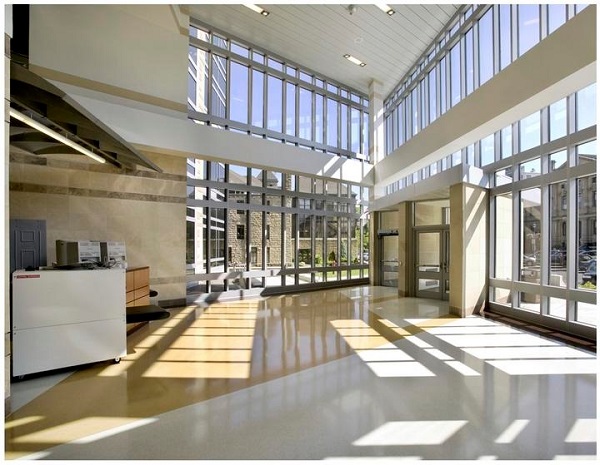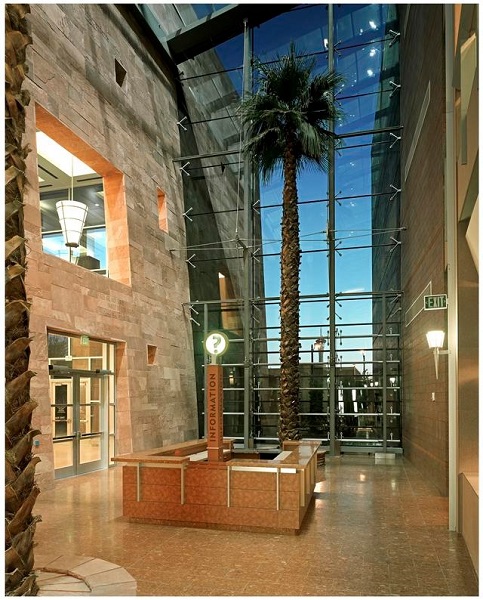The lobby serves as the main public entry into the courthouse.Functionally it must accommodate large numbers of people and provide information that allows visitors to find their destination in the building. In large, busy courthouses, a staffed information desk should be located in a highly visible location near the main entrance just inside the security perimeter. Interactive touch screen displays can provide directional as well as other building or case information.
 |
|
Loraine County, Ohio Courthouse Entrance and Lobby |
 |
|
Clark County, Nevada Courthouse Entrance with Info Kiosk |
The lobby serves both a functional and symbolic purpose. Symbolically, grand public spaces are used to convey dignity and majesty, and provide a sense or order and orientation. Functionally it has to accommodate large numbers of people who come to the courthouse on a daily basis, orient them to the building, and provide information on court services and court cases.
The size and design of the entry lobby and the location of the queuing should accommodate the peak flow of people into the courthouse during the morning’s peak hours as well as allow for people to be processed through the security checkpoint(s). The size will vary with the size of the building.
The area outside the main entrance should be covered to provide protection from rain and snow for people waiting to enter the courthouse.
The lobby should be inviting and well lit. Lots of natural day light is desirable.
All areas of the public lobby should be accessible to persons with disabilities. For more detailed information, see Disability Entrances to the Courthouse.
The main entry should be configured to allow visitors and staff to enter through a dedicated entry door. A dedicated exit door, separate from and adjacent to the entry door, should allow people to exit from the building without interfering with the security checkpoint or queue.
From the main entrance, it should be easy to find and access the vertical circulation to all courtrooms, any high volume courts such as traffic, jury assembly room, the clerks’ public service counters and the entrances to other building occupants.
The specified queuing area for security screening should not be included in the circulation space. The queuing area for security should be located off to the side so that it does not impede the flow of people (i.e., staff entering and staff/public leaving).
The entry should be easily accessible from public parking or public transportation.
An entry screening station consisting of a metal detector and x-ray machine should be located at every public entrance to the courthouse.
A Building Security Control Room should be located close to the main public entry and provide space for at least two security staff. It should be located so that there is a clear, unobstructed view of the main entry, including the security screening stations.
For more detailed information, see Entrance and Lobby Security.
In large busy courthouses, a staffed information desk may be considered. If included, it should be located in a highly visible area near the main entrance just inside the security perimeter and clearly identified.
There should be a building directory and a building schematic diagram located at the main public entrance that lists all offices in the building.
Automated electronic docket screens should be located in the main lobby of the building. These screens should not display juvenile names.
Interactive touch screen displays that can provide directional as well as other building or case information can be located in the lobby or elsewhere in the building.
